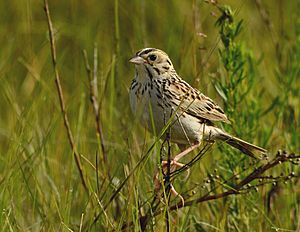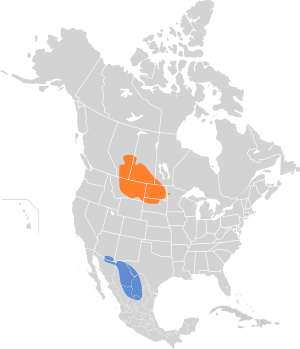Baird's sparrow facts for kids
Quick facts for kids Baird's sparrow |
|
|---|---|
 |
|
| Conservation status | |
| Scientific classification | |
| Genus: |
Centronyx
|
| Species: |
bairdii
|
 |
|
The Baird's sparrow (Centronyx bairdii) is a small bird found in North America. It's known for its pretty brown feathers and unique yellow-brown face. These sparrows travel long distances, flying from Canada and the northern United States to Mexico for winter. They are part of the Passerellidae family, which includes many types of sparrows.
Contents
Description
The Baird's sparrow is a small, streaky brown bird. Its face is a mix of yellow and brown with faint black marks. You might notice a thin band of brown streaks on its chest. A special feature is a wide, yellowish-brown stripe on top of its head. Young sparrows look similar but often have more streaks.
Both male and female adult sparrows are about the same size. They are usually around 12 centimeters (5 inches) long and weigh about 17-21 grams (½ to ¾ ounce). Their wings can spread about 23 centimeters (9 inches) wide.
Baird's sparrows are bigger than Le Conte's sparrows and don't have orange on their faces. They look a lot like Henslow's sparrow but don't have green on their faces. The Savannah sparrow has more streaks and an extra white mark on its head.
Where they live and their home
Baird's sparrows are migratory birds. This means they fly to different places depending on the season. In the summer, they live and breed in the tall grass prairies of the north-central United States and south-central Canada. When winter comes, they fly south to northern Mexico and the southern tip of Texas.
Because they migrate, you might see them across the Midwest United States during spring and fall. However, they are most often found in North Dakota, South Dakota, Minnesota, Montana, and Canada during the summer.
These sparrows need grassland habitats to survive. They rely on tallgrass prairies, mixed grass prairies, and moister fescue prairies. Sadly, these habitats are shrinking, which puts many animals, including the Baird's sparrow, in danger. Areas with lots of trees or farmed land are usually not good places for Baird's sparrows to live.
What they eat
Baird's sparrows find their food on the ground. They mainly eat insects and grass seeds.
Protecting the Baird's sparrow
There is some worry about the Baird's sparrow's numbers. Their population is smaller than it used to be. However, the species is currently listed as "least concern" on the IUCN Red List. This means they are not in immediate danger of disappearing.
It's very important to protect their natural homes. Creating new habitats artificially doesn't work well for these birds. When their habitat is broken up into smaller pieces, it can cause problems. For example, it can lead to more nest parasitism. This is when other birds, like cowbirds, lay their eggs in the sparrow's nest, and the sparrows end up raising the cowbird chicks instead of their own.
Life cycle and babies
Baird's sparrows build their nests on the ground. They usually choose a small dip in the ground or a clump of grass. Their nests are made of two layers of grass, with finer, softer material on the inside. These birds often nest in small, loose groups.
A female sparrow usually lays two to six eggs. The eggs are white-gray with brown spots. When the chicks hatch, they are altricial. This means they are born helpless, without feathers, and cannot see. They depend completely on their parents to feed and care for them until they are old enough to leave the nest.
Why they are called Baird's sparrow
The Baird's sparrow was named after an American naturalist named Spencer Fullerton Baird. A naturalist is someone who studies nature.
A historical fact
The Baird's sparrow was first officially described in North Dakota in 1843 by John James Audubon. After that first sighting, it took 29 years before anyone recorded seeing this species again!
Fun facts
The number of Baird's sparrows that breed in an area can change each year. This is probably because their environment changes. Things like wildfires, dry weather (drought), and even the movement of bison herds can affect them.
If a Baird's sparrow feels threatened or sees a predator, it might try to escape by running away on the ground instead of flying!
See also
 In Spanish: Gorrión sabanero pálido para niños
In Spanish: Gorrión sabanero pálido para niños


